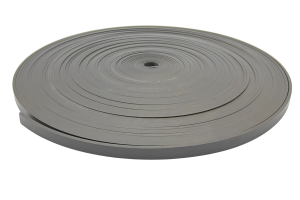液压缸密封件安装在液压泵、液压马达的轴上,起着防止工作介质沿轴向壳体外泄漏以及外部粉尘侵入机体内部的作用。由此可见,选择一家信誉良好的液压密封件厂家是十分重要的。
类别:活塞密封、杆密封、静密封、旋转密封
功能: 防止工作介质的泄漏
组成: 活塞密封、杆密封、静密封、耐磨环、轴承导向等。
特性: 优异的耐磨性、抗挤压性、抗冲击性。优质的特性依赖于优秀的液压密封件工厂。
密封是防止工作介质的泄漏(内泄漏和外泄漏)和防止外界异物(如空气、灰尘和水等)进入液压元件和液压系统的机构。正确的密封需要与高质量的液压密封件厂合作。
密封件虽然在液压设备中属于辅助零部件,但是密封件及密封装置的质量却是直接影响液压系统能否正常工作的关键之一,密封件的质量在一定程度上制约了液压元件及液压系统性能和可靠性的提高、使用寿命的长短,是液压设备的档次和水平以及参与国际竞争的关键,这也是造成国内外液压元件质量差异的主要因素之一。往往个别密封件失效所造成的损失可能是密封件本身价值的几千万倍。
防尘密封
活塞杆密封
它安装在液压缸端盖内侧的防尘密封圈内,其作用是防止液压油的泄漏,是主要承压元件之一,承受单向压力,承受压力较大,与液压油直接接触,要求静态保压性能好,运动时承压性能高,密封性能好,摩擦因数小,抗挤压能力强。
活塞杆密封件的截面形式和材料有多种,根据不同的工作环境选用不同的截面形式和材料。
活塞密封
安装在活塞上,其主要作用是密封活塞与缸体之间的间隙,防止液压油内漏。活塞密封是液压缸内的主要密封,承受两个方向的压力,是液压缸承受压力值最重要的密封之一。对活塞密封的主要要求是密封效果好,静态保压效果好,运动时承压能力强,抗挤压,摩擦系数小,使用寿命长等。
活塞密封件的形式多种多样,应根据不同的使用环境选择最合适的形式。

耐磨环

安装在液压缸端盖内侧,其主要作用是支撑活塞杆;防止活塞杆受到垂直受力而造成杆密封受压不均,造成密封效果差,使用寿命短。
轴承环
安装在活塞上,其主要作用是引导活塞做直线运动,防止活塞因受力不均而发生偏斜,造成内泄漏,降低密封件的使用寿命。
耐磨环和导向带的使用寿命直接影响活塞密封件和活塞杆密封件的使用效果和寿命,因此对耐磨环和导向带的要求也较高,如摩擦系数小、硬度高、使用寿命长等。
磨损环和轴承环有多种形式,并与主密封结合使用。

静密封

端盖静密封环安装在端盖外圆与液压缸内壁接触处;活塞静密封环安装在活塞与活塞杆之间。
它们都是液压缸内的静密封圈,端盖静密封是防止液压油从端盖与缸筒之间的缝隙中漏出,是单面承压,要求抗挤出能力强,密封效果好;活塞静密封是双向承压,防止液压油从活塞与活塞杆之间漏出,要求抗挤出能力强,密封效果好。
常见的静密封圈有O形圈、挡圈等。
旋转密封
安装在液压泵、液压马达的轴上,防止工作介质沿轴从壳体内漏出及防止外界粉尘反应侵入机体内部。一般油封耐压能力较差,一般为0.2-0.3MPa,氟橡胶耐压油封承压能力为0.25-0.7MPa,TYS Seals高压油封最高承压能力可达40MPa。

泄漏的原因与安装问题、密封件选择问题以及液压密封件厂家的选择有关。
泄漏的主要原因有:
安装问题
1、密封件安装方向错误,造成泄漏。
2、安装时可能混入异物、灰尘等或进入管道内的密封腔,造成泄漏。
3、装配不良造成密封损坏,造成泄漏。
4、密封件表面有划痕,造成泄漏。
5、活塞杆不同心,偏载造成泄漏。
密封件选择问题
1、压力过大,密封件硬度太小而被挤出金属槽。
2、密封材料与介质互溶,密封件软化或溶解。
3、密封使用环境温度过高,密封材料碳化。
4、低温使密封材料硬化、收缩,造成泄漏。
5、使用速度过高,造成密封件发热、干磨、碳化而形成泄漏。
6、运行条件下润滑不良造成密封磨损和泄漏。
7 、使用腔体受到振动,造成泄漏。
8 、因灰尘引起密封件磨损而造成泄漏。
9、密封件硬度太高,不能完全填满金属凹槽,造成泄漏。
10 、密封件尺寸与金属沟槽不匹配,造成泄漏。
11 、选择存放时间过长、老化的密封件,可能会造成泄漏。
12、选择一家优质的液压密封件工厂也非常重要。
依赖不合格的密封件工厂会导致密封性能不佳。与久经考验的液压密封件工厂合作可提高质量和可靠性。
通过为您的应用选择最佳的液压密封件工厂,可以通过稳健的设计和生产控制避免许多泄漏问题。
密封材料
密封材料主要采用聚四氟乙烯、橡胶、合成树脂等,由于各种材料的性能特点不同,其用途也不同,选用时需要根据不同的使用要求、不同的使用条件进行适当的选择。
由某种材料制成的密封件,对于被密封的某种工作介质,其密封性能良好,但对于另一种介质,其密封性能却极差,这就是密封材料与液压油的相容性。
密封材料与液压油的兼容性也至关重要。理想的液压密封件工厂将拥有 PTFE 和橡胶化合物等各种材料的专业知识,以提供适合您特定流体和应用环境的解决方案。










